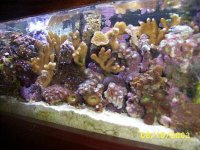Hello Ticeman, and Welcome to Reefs dot Org!
I like to look for this in LR choices:
1. Porosity. I don't like the large limestone blocks and other rocks sometimes sold as LR or baserock. It will eventually colonize with living organisms once its in a thriving reef tank, but for Nano purposes we are usually looking for biological filtration and so I look for nice fiji or tonga rock having lots of pores and holes, and relatively light weight per unit indicating a porous internal structure as well. Usually any LR that is taken naturally works just fine. I can't say there is a measurable scientific difference between my preferences and using any other rock, but I just like my way and have had great results.
2. Hitchikers. I actually like very few hitchikers on my rocks. Lots of sponges, hydroid colonies, unidentified corals etc have uncertain lifespans in nano tanks (pico tanks!), so I figure the less die-off the better. I like porous, coralline-covered rocks so I don't have to wait as long for my aquascape to purple up. Now if someone gave me some $14/lb LIVE LR I would definately use it!! I have seen in time though that LR biodiversity decreases in a nano, but also gets very specific in supporting certain kinds of LR growth such as specific hydroid colonies, certain sabellids (fanworms etc). The diversity of LR life seems to decline in our nanos, but that's not to say that life in general will decline over time. In my reefbowl, LR supports many kinds of sabellids and hydroids but not many kinds of sponges...thats just my system.
3. Algae. None of any kind ever! I feel it is very dangerous to import whole algal colonies into our small reefs. yes there are ubiquitous spores everywhere that will seed in the right nutrient conditions, but a fully-formed organism has the best chance of thriving and reproducing so I say don't buy any pieces that have green, brown or red algae attached to them. Pulling it off doens't help either, small particles are left behind. Go for rock that has no filamentous algae if you can.
4. White spots. Various organisms could be dead or decaying. They can be removed with a toothbrush if they are small and on a piece you just have to have...
Can you guys think of anything else?






